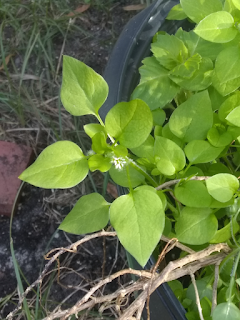Welcome back to an entirely new year of LITFM! We took a long hiatus to get our YouTube channel's second season completed and now this blog is back in action. So to get things rolling and at the request of some folks who visit the Farmer's market, this is the first part of a series on edible forage foods in finer detail.
 |
| It is hard to believe but this is just a few plants that have intertwined and formed a dense but deliciously edible mat of healthy greens. |
 |
| Here is a close-up of the foliage and flower of a Chickweed plant. |
Common Name: Common Chickweed
Other Common Names: Chickenwort, Craches, Maruns and Winterweed.
Botanical Family: Caryophyllaceae (The Pink/ Carnation Family)
Botanical Latin Name: Stellaria media
Season to Harvest: Late winter through spring.
Habitat: Commonly found in yards, disturbed sites, moist and wet soil areas, cultivated land, the woods, and may appear in containers with other cultivated plants.
Parts to Harvest: Foliage and flowers,
Poisonous Lookalikes: None in the USA.
Related Edible Species: None in North Carolina.
Description: Chickweed is a cool-season annual herb that can have stems that grow up to 12” high. The seeds of Chickweed germinate in autumn or late winter and the plants persist until the first consistently warm weather arrives in late spring or early summer. The best way to identify chickweed is noting what time of the year it is and looking for its oppositely positioned leaves and, white ten-petaled flowers. The foliage of Chickweed is slightly hairy but it overall has a smooth appearance. Leaves are often no bigger than 1.4 inches long roughly egg-shaped. This plant is at its best before it blooms but is edible after it blooms.
How to Harvest: You can pick individual leaves if they are big enough however this is very time consuming. I typically will take a pair of garden snippers or scissors and shear off sections of the plants then check for foreign objects like larger leaves or pine needles and then wash the stems and leaves I’ve harvested. If you really need a lot of this herb in a hurry you can pull up the entire mass by the roots but this method will bring in a lot more foreign debris which can complicate washing and preparation.
Recipe: Chickweed is perfectly fine raw in a salad though I do advise washing it thoroughly before eating it this way. In terms of flavor Chickweed is fairly mild, and is a bit more flavorful than iceberg lettuce and certainly more nutritious. My preferred way to cook this herb is to use it as a replacement for Spinach in other recipes though one should be mindful that it is a delicate herb and it cooks very quickly so it should be added in the last five or so minutes of cooking to ensure it retains any texture. By itself it can be cooked as simple pot herb by boiling it for 2 to 5 minutes and being served with your preferred seasonings, butter and a small cropped onion. The aforementioned if served with rice is a pretty healthy meal.
With all that garden goodness covered this is the part of the blog where I have to advertise for the Fayetteville City Market. Now I know you readers probably don’t much like advertisements, but by booth at the City Market helps to cover the costs of running the test garden and literally maintains the Research & Development budget that is used to bring you the information that has made up the backbone of this blog. Also, as of the start of 2019, my booth can now process credit or debit cards thanks to the acquisition of s a Square reader so your payment options have doubled. With that said, if you want to get some GMO-free, Organic fruit, herbs, flowers and perennials, come on down to the Fayetteville City Market on 325 Maxwell Street in downtown Fayetteville between the Hours of 9:00 am and 1:00 pm on Saturdays. Even in bad weather the market goes on though you might have to look for me under the ‘arches’ of the Transportation Museum’s front entryway.
For those of you wondering what plants are going to be at the market this weekend here is the list.
Produce:
Garlic Bulb, $1.00
Soup Kit – Parsnip, $6.00
Soup Kit – Turnip, $6.00
Seasoning Packet, $2.00
Houseplants:
Assorted Succulents, Plastic Pot ($5.00)
Assorted Succulents, Round Resin Pot - $5.00
Assorted Succulents, Square Resin Pot - $5.00
Assorted Succulents, Hexagon Resin Pot - $10.00
Assorted Succulents, Lattice Resin Pot - $14.00
Assorted Succulents, Clay Pot ($9.00)
Garden Stuff:
Elephant Garlic
Softneck Garlic
Coming Soon
Lettuce – Parris Island Romaine
Lettuce – Cherokee Red
Lettuce –Five Star Blend
Beets – Bull’s Blood
Mustard – Red Giant
How to stay in Contact with Us!
Our group’s online presence has migrated to Nextdoor.com. All you need to keep up with all our activities is to have a Nextdoor account and to look for the ‘Sustainable Neighbors of Fayetteville’ group and ask to join! You don’t have to live in Fayetteville to join us! Feel free to ask all your garden questions of our knowledgeable membership and post your cool garden pictures.
https://nextdoor.com/g/ybvdm226x/?is=nav_bar
Also please take a gander at the Youtube version of this blog:
The Videos: https://www.youtube.com/user/curacaovexxor/videos
>Newest videos (5): Chinese Money Plant, Red African Milk Bush, Pencil Cactus, Desert Rose, ‘Prehistoric’ Devils Backbone.
Meetings still going on! We now meet at LeClairs General Store on the First and Third Thursday of every month. Our next meeting is on March 3rd between 5:30pm and 7:00pm. We are in the back room so come on in and join us for a fun garden chat.